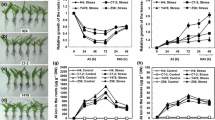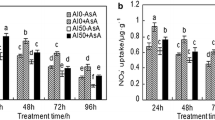Abstract
Aluminum (Al) affects numerous physiological processes in plants. However, Al tolerance mechanisms mediated by increased synthesis of organic acids (OAs) have been outlined recently. In this study, we examined the role of OAs in the short (1–8 h) and long-term (4 days) Al tolerance in maize seedlings. Exposure to Al stress for 4 days results in a rapid inhibition of root growth. Al induced morphological changes in the maize roots, especially at a higher solution of Al concentration (1,000 μM Al). The increase in Al accumulation in roots, including strongly elevated levels of Al accumulated in root cell walls suggests that Al tolerance in maize is mediated in part by higher accumulation of Al in the roots. The enhanced citrate exudation, which was only observed at 1,000 μM Al may lead to detoxification of Al by formation of OA–Al complexes in the root apoplast. This mechanism has been suggested to play a significant role in Al resistance response in maize. The short-term responses underlying internal detoxification via OA-chelators were also investigated. Succinate, malate, citrate and total root OA contents decreased markedly, 2 h after the Al exposure. At 4 and 8 h time points, OA contents increased or remained unchanged, except for that of malate which decreased. The level of OAs in shoots, on the other hand, showed alterations that were less pronounced in response to Al. Specifically, the citrate and total OA concentrations significantly increased at 4 h, but showed a pronounced decrease at the 8 h time point. Based on our findings, we propose that multiple responses, including Al exclusion by Al accumulation in root cells and citrate efflux, may contribute towards higher Al resistance in maize. The rapid OA changes in responses to short-term Al treatment may not be responsible for Al tolerance. However, increased OA synthesis observed in this study may be involved in diminishing the stress triggered by Al. The molecular aspects underlying Al resistance mechanism via Al-induced expression of the enzymes catalyzing OA synthesis and metabolism remain to be elucidated.








Similar content being viewed by others
References
Apel K, Hirt H (2004) Reactive oxygen species: metabolism, oxidative stress, and signal transduction. Annu Rev Plant Biol 55:373–399. doi:10.1146/annurev.arplant.55.031903.141701
Barceló J, Poschenrieder C (2002) Fast root growth responses, root exudates, and internal detoxification as clues to the mechanisms of aluminium toxicity and resistance: a review. Environ Exp Bot 48:75–92. doi:10.1016/S0098-8472(02)00013-8
Blancaflor EB, Jones DL, Gilroy S (1998) Alterations in the cytoskeleton accompany aluminum-induced growth inhibition and morphological changes in primary roots of maize. Plant Physiol 118:159–172. doi:10.1104/pp.118.1.159
Boscolo PR, Menossi M, Jorge RA (2003a) Aluminum-induced oxidative stress in maize. Phytochemistry 62:181–189. doi:10.1016/S0031-9422(02)00491-0
Boscolo PR, Menossi M, Jorge RA (2003b) Aluminum-induced oxidative stress in maize. Phytochemistry 62:181–189. doi:10.1016/S0031-9422(02)00491-0
Cathala N, Salsac L (1975) Absorption du cuivre par les racines de maïs (Zea mays L.) et de tournesol (Helianthus annuus L.). Plant Soil 42:65–83. doi:10.1007/BF02186974
Chaffai R, Marzouk B, El Ferjani E (2005) Aluminum mediates compositional alterations of polar lipid classes in maize seedlings. Phytochemistry 66:1903–1912. doi:10.1016/j.phytochem.2005.06.028
Chandran D, Sharopova N, Ivashuta S, Gantt JS, VandenBosch KA, Samac DA (2008) Transcriptome profiling identified novel genes associated with aluminum toxicity, resistance and tolerance in Medicago truncatula. Planta 228:151–166. doi:10.1007/s00425-008-0726-0
Clarkson DT (1965) The effect of aluminium and some other trivalent metal cations on cell division in the root apices of Allium cepa. Ann Bot (Lond) 29:309–315
Deleers M, Servais JP, Wulfert E (1986) Neurotoxic cations induce membrane rigidification and membrane fusion at micromolar concentrations. Biochim Biophys Acta 855:271–276. doi:10.1016/0005-2736(86)90174-4
Delhaize E, Ryan PR (1995) Aluminum toxicity and tolerance in plants. Plant Physiol 107:315–321
Delhaize E, Ryan PR, Randall PJ (1993) Aluminum tolerance in wheat (Triticum aestivum L.). II. Aluminum-stimulated excretion of malic acid from root apices. Plant Physiol 103:695–702
Delhaize E, Benjamin DG, Ryan PR (2007) The roles of organic anion permeases in aluminium resistance and mineral nutrition. FEBS Lett 581:2255–2262. doi:10.1016/j.febslet.2007.03.057
Delisle G, Champoux M, Houde M (2001) Characterization of oxalate oxidase and cell death in Al-sensitive and tolerant wheat roots. Plant Cell Physiol 42:324–333. doi:10.1093/pcp/pce041
Hayes JE, Ma JF (2003) Al-induced efflux of organic acid anions is poorly associated with internal organic acid metabolism in triticale roots. J Exp Bot 54:1753–1759. doi:10.1093/jxb/erg188
Heath RL, Packer L (1968) Photoperoxidation in isolated chloroplasts. I. Kinetics and stoichiometry of fatty acid peroxidation. Arch Biochem Biophys 125:189–198. doi:10.1016/0003-9861(68)90654-1
Horst WJ, Asher CJ, Cakmak I, Szulkiewicz P, Wissemeier AH (1992) Short-term responses of soybean roots to aluminium. J Plant Physiol 140:174–178
Jentschke G, Schlegel H, Godbold DL (1991) The effect of aluminium on uptake and distribution of magnesium and calcium in roots of mycorrhizal Norway spruce seedlings. Physiol Plant 82:266–270. doi:10.1111/j.1399-3054.1991.tb00092.x
Kochian LV (1995) Cellular mechanisms of aluminum toxicity and resistance in plants. Annu Rev Plant Physiol Plant Mol Biol 46:237–260. doi:10.1146/annurev.pp.46.060195.001321
Kochian LV, Jones DL (1997) Aluminum toxicity and resistance in plants. In: Yokel RA, Golub MS (eds) Research issues in aluminum toxicity. Taylor and Francis, Washington, pp 69–89
Kochian LV, Piñeros MA, Hoekenga OA (2005) The physiology, genetics and molecular biology of plant aluminum resistance and toxicity. Plant Soil 274:175–195. doi:10.1007/s11104-004-1158-7
Lazof DB, Goldsmith JG, Rufty TW, Linton RW (1994) Rapid uptake of aluminum into cells of intact soybean root tips: a microanalytical study using secondary ion mass spectrometry. Plant Physiol 106:1107–1114
Ma JF, Zheng SJ, Hiradate S, Matsumoto H (1997) Detoxifying aluminum with buck wheat. Nature 390:569–570. doi:10.1038/37518
Martinoia E, Rentsch D (1994) Malate compartmentation responses to a complex metabolism. Annu Rev Plant Physiol Plant Mol Biol 45:447–467
Miyasaka SC, Hue NV, Dunn MA (2006) Handbook of plant nutrition. In: Allen VB, David JP (eds) Aluminum. CRC Press, University of Hawaii-Manoa, Hilo, pp 437–497
Pan J, Zhu M, Chen H (2001) Aluminum-induced cell death in root-tip cells of barley. Environ Exp Bot 46:71–79. doi:10.1016/S0098-8472(01)00083-1
Pan JW, Ye D, Wang LL, Hua J, Zhao GF, Pan WH, Han N, Zhu MY (2004) Root border cell development is a temperature-insensitive and Al-sensitive process in barley. Plant Cell Physiol 45:751–760. doi:10.1093/pcp/pch090
Parker DR, Kinraide TB, Zelazny LW (1988) Aluminum speciation and phytotoxicity in dilute hydroxylaluminum solutions. Soil Sci Soc Am J 52:438–444
Piñeros MA, Magalhaes JV, Alves VMC, Kochian LV (2002) The physiology and biophysics of an aluminum tolerance mechanism based on root citrate exudation in maize. Plant Physiol 129:1194–1206. doi:10.1104/pp.002295
Piñeros MA, Shaff JE, Manslank HS, Alves VMC, Kochian LV (2005) Aluminum resistance in maize cannot be solely explained by root organic acid exudation. A comparative physiological study. Plant Physiol 137:231–241. doi:10.1104/pp.104.047357
Raynal DJ, Joslin JD, Thornton FC, Schaedle M, Henderson GS (1990) Sensitivity of tree seedlings to aluminum. III. Red spruce and loblolly pine. J Environ Qual 19:180–187
Rengel Z (1992) Role of calcium in aluminum toxicity. New Phytol 121:499–513. doi:10.1111/j.1469-8137.1992.tb01120.x
Rengel Z (1996) Uptake of aluminium by plant cells. New Phytol 134:389–406. doi:10.1111/j.1469-8137.1996.tb04356.x
Sivaguru M, Horst WJ (1998) The distal part of the transition zone is the most aluminum-sensitive apical root zone of maize. Plant Physiol 116:155–163. doi:10.1104/pp.116.1.155
Taylor GJ (1991) Current views of the aluminum stress response; the physiological basis of tolerance. Curr Top Plant Biochem Physiol 10:57–93
Tesfaye M, Temple SJ, Allan DL, Vance CP, Samac SA (2001) Overexpression of malate dehydrogenase in transgenic alfalfa enhances organic acid synthesis and confers tolerance to aluminum. Plant Physiol 127:1836–1844. doi:10.1104/pp.010376
Thorne CJ, Grossman LI, Kaplan NO (1963) Strach-gel electrophoresis. Biochim Biophys Acta 73:193–203. doi:10.1016/0006-3002(63)90303-2
Yamamoto Y, Kobayashi Y, Matsumoto H (2001) Lipid peroxidation is an early symptom triggered by aluminum, but not the primary cause of elongation inhibition in pea roots. Plant Physiol 125:199–208. doi:10.1104/pp.125.1.199
Yang ZM, Sivaguru M, Horst WJ, Matsumoto H (2000) Aluminium tolerance is achieved by exudation of citric acid from roots of soybean (Glycine max). Physiol Plant 110:72–77. doi:10.1034/j.1399-3054.2000.110110.x
Zhang G, Taylor GJ (1990) Kinetics of aluminum uptake in Triticum aestivum L.: identity of the linear phase of aluminum uptake by excised roots of aluminum-tolerant and aluminum-sensitive cultivars. Plant Physiol 94:577–584. doi:10.1104/pp.94.2.577
Acknowledgments
This paper is dedicated to Professor Brahim Marzouk (Biotechnology Center, Borj Cedria Technopark, Hammam-Lif, Tunisia) on the occasion of his retirement, in recognition of his significant contribution to plant biochemistry and physiology. We greatly appreciate the significant contribution of Dr. Sami Ben Jamaa during writing of the manuscript, and Mrs Najeh Galai for her technical assistance. This work was financially supported by the Ministry of Higher Education, Scientific Research, and Technology of Tunisia.
Author information
Authors and Affiliations
Corresponding author
Additional information
Communicated by G. Klobus.
Rights and permissions
About this article
Cite this article
Chaffai, R., Marzouk, B. The role of organic acids in the short- and long-term aluminum tolerance in maize seedlings (Zea mays L.). Acta Physiol Plant 31, 805–814 (2009). https://doi.org/10.1007/s11738-009-0295-2
Received:
Revised:
Accepted:
Published:
Issue Date:
DOI: https://doi.org/10.1007/s11738-009-0295-2




